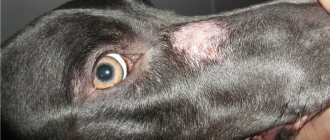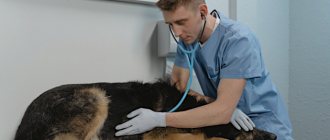How serious and dangerous is it when a dog has bloody stool? If there is fresh blood in the stool, this indicates bleeding from the lower gastrointestinal tract. But not only profuse red blood is a dangerous condition. The appearance of the slightest streaks of blood and black, tarry stool should alert the owner, otherwise it could cost the dog’s life.
Blood in dog stool
Normally, there should be no blood in a dog's feces. Its presence in the form of black feces, interspersed with cords, drops, and pinkish mucus indicates gastric bleeding and requires immediate assistance from a veterinarian. Treatment should be started as early as possible, otherwise complications can lead to death.
Animal treatment: therapy methods and remedies
Nursing a sick pet should be entrusted to specialists at a veterinary clinic.
Self-medication: why you shouldn’t do it
At home it is impossible to determine the cause of the pathology. To do this, it is necessary to conduct an endoscopic or x-ray examination, ultrasound, and take clinical tests.
In any case, the use of medications without making an accurate diagnosis is dangerous for the dog’s life.
For helminthiasis
Treatment depends on the cause of the pathological condition. If worm eggs are found in the dog’s feces, the following drugs are prescribed to destroy them: Drontal Plus, Prazicide, Inspector Total S.
If there are problems with the gastrointestinal tract
For severe bleeding, Vikasol, Calcium Gluconate, Dicinone are prescribed.
To relieve pain, you need to take antispasmodics (No-Shpa, Papaverine). To normalize the functioning of the gastrointestinal tract in the post-traumatic period, Catozal, Veracol, Clamoxil are prescribed.
To restore the intestinal microflora and stop diarrhea, probiotics are needed (Lactobacterin, Symbiolact, Enterol).
Neoplasms in the intestines
The tumor can only be removed surgically. Treatment of intestinal cancer is supplemented with radiotherapy and chemotherapy. The owner needs to mentally prepare for this difficult stage in the dog’s life.
Infections
If the infectious origin of the disease is confirmed, antibacterial therapy is indicated. The following broad-spectrum drugs are effective: Ceftriaxone, Amoxicillin, Levomycetin.
Cause of blood in stool
Blood in the stool or hematochezia, a pathology indicating the presence of blood in an unchanged form. It indicates internal damage to the soft tissues of the gastrointestinal tract, which are located closer to the anus.
Dark, almost black stool “speaks” of bleeding in the upper intestine and the stomach itself. At the same time, the blood has time to be partially digested.
Why there is blood, list of reasons:
- Blood and particles of undigested food cause damage to the capillaries of the rectum and colon.
- Red, sometimes scarlet blood - injury to the anus and rectal walls.
- Proctitis, inflammatory processes in the gastrointestinal tract.
- Viral (intestinal) infections in acute form (gastroenteritis, parvovirus).
- Neoplasms along the intestine and their injuries, degeneration (polyps, malignant tumors).
- Ulcers, erosions on the walls of the intestines and stomach.
- Blood clotting disorder.
The risk group includes puppies and adult dogs of toy and miniature breeds. Bleeding and dehydration have a serious impact on the functioning of the body, so help must be provided immediately.
Types of bleeding
If the gastrointestinal tract is disrupted, blood may appear in the animal's stool. The discharge may vary in appearance and color. It depends on the nature of the damage to the dog’s body.
Usually, bleeding is divided into two large groups based on color:
- The color is red, scarlet corresponds to secretions that have retained their structure and have a state close to natural. Such blood is called native. Bleeding usually occurs in one part of the intestine.
- The color is brown, dark, comparable to coffee grounds, they have secretions that have interacted with enzymes. This may indicate problems with the animal's esophagus, stomach, or initial intestine.
Provoking factors
In 90% of cases, blood in the stool appears as a result of improper maintenance and feeding of the dog. This applies to owners who practice giving their pet chicken bones, bone residue (ground up chicken sinews and bones). Sharp fragments injure the mucous membrane along the entire length of the gastrointestinal tract, often damaging the muscle layer, causing heavy bleeding, perforation and peritonitis.
Worms (giardiasis, trichomnosis, toxocariasis, etc.) violate the integrity of the intestinal walls, damage the smallest capillaries and provoke bleeding.
Incorrect administration of medications (corticosteroids, NSAIDs) affects blood clotting. That is why they are taken strictly according to the regimen prescribed by the veterinarian.
Poisoning with poisons (zoocoumarin, etc. from rats), which interfere with blood clotting, and chemicals is dangerous.
Prevention
It is difficult to completely exclude the possibility of developing diarrhea, because a Yorkie can develop loose stools even from a stressful situation. But every owner is obliged to minimize digestive disorders in their four-legged pet. It is enough to be attentive to your pet: feed only fresh and high-quality food, make sure that the animal does not pick up anything on the street, carry out vaccinations and deworming in a timely manner.
The health of a small lap dog is entirely in the hands of its owner. When purchasing such a dog, a person must be prepared for special care for it. Whether the Yorkie will be healthy and happy depends only on its owner.
Associated symptoms
The presence of blood in a dog's stool may be accompanied by the following signs:
- Apathy, anorexia (loss of appetite).
- Vomiting and diarrhea.
- Increased or decreased body temperature.
- Rapid breathing.
- Mucus in feces, unpleasant odor.
- Paleness of the mucous membranes, tongue, gums.
Often there is a cough, discharge from the eyes and nose, obvious pain when palpating the abdomen, and sudden weight loss.
Important! Red pigments in stool do not always indicate blood or bleeding. If you eat vegetables with red juice (beets), your feces may turn ruby red. Bitches in heat can also confuse the owner when walking.
Treatment
The following basic activities are required:
- If possible, eliminate the causes of the disease.
- Hemostatic agents.
- Replenishment of circulating blood volume.
- Detoxification therapy.
- Maintains liver and kidney function.
- Prevent your dog from eating feces.
- Antibacterial, anti-inflammatory drugs according to indications.
- Compliance with diet.
- Local treatment in the form of enemas, gastric lavages, if prescribed by a veterinarian.
Prevention after recovery consists of regular examinations by a veterinarian, preventive vaccinations, anthelmintics, and proper nutrition to avoid relapses.
Currently reading:
- What to do if your dog vomits blood
- Is it worth it or not to include natural food in your dog’s diet?
- 13 Causes of Indigestion and Diarrhea in Dogs
- 8 ways to treat papillomas on a dog’s body
What should the owner do: first aid
If your dog has blood in his stool or his feces turn black, you should immediately take your pet to a veterinarian. In this case, it is desirable to accurately describe the nature of the bleeding (scarlet blood in drops, strands, pink mucus, etc.). This information will help the specialist make an accurate diagnosis.
Episodes with severe bleeding and bloody diarrhea are especially dangerous; here help should be immediate.
If the appearance of blood is associated with incorrect or self-administration of drugs, the owner must inform the doctor about this. Feeding with bones, possible injuries from swallowing foreign sharp objects, poisoning rats in the house - everything needs to be discussed with a specialist.
Causes of the disease
How can you understand why a dog poops blood? Bleeding can develop as a result of injury or serious illness.
Types of diseases leading to bleeding in dogs:
- tumor;
- infectious;
- exchange;
- somatic.
There are 3 types of blood in a dog’s stool:
- scarlet blood in large quantities;
- streaks of blood;
- tarry liquid stool.
- white chair
List of diseases accompanied by bleeding in dogs:
- haemorrhoids;
- constipation, formation of anal fissures;
- infectious, toxic gastroenteritis;
- space-occupying formations in the stomach and intestines at any level, helminthiases;
- ulcers in the stomach, duodenum (duodenum);
- pancreatitis in a dog.
Diagnostics
An accurate diagnosis will be made most quickly and treatment will be prescribed if the owner can tell in as much detail as possible what could have led to the appearance of blood in the stool. This will save the doctor time, allow him to postpone some diagnostic procedures and begin to eliminate the cause and consequences.
During the examination the following is prescribed:
- General urine and blood tests.
- Infection testing.
- Ultrasound of the abdominal cavity.
- X-ray, endoscopy.
Be sure to exclude/confirm the presence of sharp objects, bones, polyps, and malignant neoplasms in the gastrointestinal tract. Assess the condition of the mucous membranes.
Symptoms of bloody diarrhea in a Yorkie
You can determine that your pet has bloody diarrhea by the following signs:
- The number of bowel movements increases to 3-4 times a day, sometimes the dog begins to empty its intestines about 10 times a day.
- The appetite completely disappears, the Yorkie does not even show interest in his favorite treats.
- Yorkie poops blood.
- The pet is shivering, and general weakness of the body is observed.
- Vomiting, discharge from the eyes and nose, and coughing may occur.
My Yorkie has diarrhea and vomiting, what should I do? If a Yorkshire Terrier also vomits during diarrhea, this will very quickly lead to dehydration and death of the pet. In such cases, your four-legged friend should be taken to the veterinarian immediately. It should be noted that vomiting is the body’s protective reaction to an irritating factor (infectious disease, poisoning with poisons and chemicals, helminths). The owner of the animal must tell the doctor about the nature of the vomiting: how often the pet vomits, whether there is mucus, blood, or foam in the vomit. If your puppy is simply vomiting, you will find this article helpful.
How to treat?
All prescriptions depend on the cause and final diagnosis; the dog may require surgical or medicinal treatment. It is strictly forbidden for the owner to independently administer medications, herbal decoctions, etc. to stop the bleeding. This can only blur the clinical picture and aggravate the situation.
In rare cases and in case of painful symptoms, in agreement with the doctor, even before arriving at the clinic, pain relief medications are given
Treatment in mild cases allows the dog to “get off” by taking hemostatic agents. If the gastrointestinal mucosa is severely damaged by sharp objects, there are erosions, ulcers, polyps or degenerating tumors, surgical intervention or the use of an endoscope will be required.
Emergency therapy is needed for poisoning, intestinal infections, and is aimed at neutralizing toxic substances or viruses. In the future, it will be necessary to stop the bleeding and restore the gastrointestinal mucosa.
Anal gland infection
The dog has two glands or sacs located on either side of the anus. When stool leaves the body, it can put pressure on these glands. These glands then empty fluid to facilitate lubrication. However, sometimes the anal glands can become infected, which may explain why your dog starts bleeding from the rectum. In these cases, the dog will feel pain and produce yellow or bloody discharge. A dog suffering from this problem is also likely to rub or drag its butt on the ground or lick the infected area.
Your veterinarian will be able to empty the glands and prescribe appropriate antibiotics to treat any infection.
Often, if the inflammation affects only one gland, it may mean that the dog has an abscess. This abscess can break the skin and cause a perianal fistula, which will release foul-smelling fluid. If this is the case, it is very important to see a veterinarian as soon as possible, as in severe cases the abscess may require surgery. Treatment of abscesses will also require disinfection and antibiotics.
The owner's first actions
Before visiting the veterinarian, you can try to stop the bleeding with folk remedies. Nettle or chamomile decoction is suitable for this. A decoction of oak bark will help cope with bacteria.
The consequences of intoxication can be eliminated with sorbents: activated carbon, Enterosgel or Polysorb. In addition to flushing out toxins, they can firm up the stool. Rice water will also cope with this.
To reduce the load on the gastrointestinal tract, put your pet on a starvation diet. If you maintain your appetite, eat soft and light foods. If the animal eats dry food, soak the granules with water.










